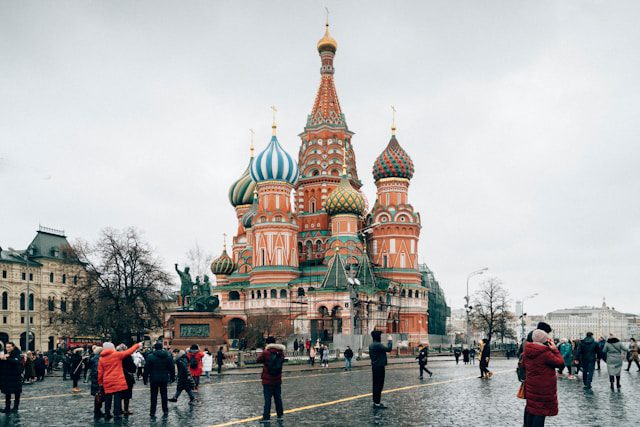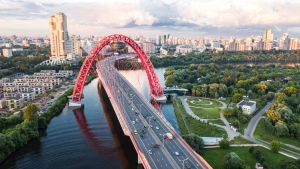Spring in Russia transforms the country dramatically from March through May as winter’s grip loosens across its vast territory. From witnessing the spectacular ice break-up on the Neva River to celebrating traditional spring festivals, this diverse nation offers unique experiences that draw visitors from around the globe.
Whether you’re planning to explore Moscow’s historical sites, witness St. Petersburg’s White Nights beginning, or experience traditional spring festivities, this comprehensive guide will help you plan your springtime journey across Russia.
Weather in Russia in Spring
Spring weather in Russia varies significantly by region and changes rapidly throughout the season, making it essential to understand local conditions for planning your activities.
|
Weather Element |
Details |
|
Temperature |
Moscow:
St. Petersburg:
|
|
Humidity |
Note: Higher humidity levels are observed in the mornings and evenings. |
|
Precipitation |
Moscow: 33-51mm monthly St. Petersburg: 31-51mm monthly March: Some snowfall April-May: Mainly rain |
|
Average Sunset Time |
Moscow:
|
With Russia’s spring weather requiring careful planning, it’s equally important to stay updated on your visa status using official online tools to ensure a smooth journey.
Why Visit Russia in Spring

Spring in Russia offers unique advantages that make it an ideal time to explore Russia’s diverse landscapes and cultural offerings. From significant cost savings to unique natural phenomena, spring deserves serious consideration for your Russian adventure.
Significant Cost Savings
Spring presents exceptional value for travellers exploring Russia. Hotel rates typically drop 20-30% from peak season prices, with luxury properties offering the most significant discounts. For example, 5-star hotels in Moscow’s city centre often reduce rates from 25,000 RUB to 18,000 RUB per night.
Museums and cultural attractions join the trend with off-season discounts ranging from 10-20%, while popular sites like the Hermitage Museum and Moscow Kremlin see their queues reduced by 30-50%, making spring visits more enjoyable and efficient.
Natural Phenomena
Spring in Russia brings several unique natural events that create unforgettable experiences. The most spectacular is the Ledokhod (ice drift) on major rivers like the Neva and Moskva, typically occurring in mid-April. This dramatic phenomenon sees massive ice sheets breaking apart and flowing downstream, creating an impressive natural spectacle.
In Moscow’s botanical gardens, native plants begin their first flowering, with the Aptekarsky Ogorod featuring special spring exhibitions of blooming Siberian species. Lake Baikal welcomes the return of migratory birds, offering birdwatchers rare glimpses of species like the black stork and spoon-billed sandpiper.
Cultural Celebrations
Spring emerges as Russia’s most culturally rich season, with celebrations marking the end of winter and welcoming warmer days. The Maslenitsa Festival, Russia’s version of Mardi Gras, features traditional pancakes, folk music, and the ceremonial burning of winter effigies.
Orthodox Easter brings elaborate celebrations with midnight services, traditional kulich bread, and beautifully decorated eggs. May celebrations showcase Russia’s rich history through Victory Day parades and commemorations.
Emerging Art Scene
Spring marks the beginning of Russia’s contemporary art season, with galleries and creative spaces launching new exhibitions after the winter break. The Winzavod Contemporary Art Center in Moscow typically hosts its major spring shows during this period.
During this time the New Holland Island in St. Petersburg opens its outdoor art installations. Many artists’ studios also open their doors for spring visitors, offering unique insights into Russia’s contemporary creative scene.
Seasonal Cuisine
Spring in Russia brings a unique seasonal menu that captures the essence of Russian culinary traditions. Markets overflow with the first wild herbs like cherry blossom leaves and ramson (wild garlic), while restaurants update their menus to feature spring delicacies like sorrel soup (schaveleviy sup) and seasonal mushrooms.
Traditional spring beverages like birch sap (beryozoviy sok) become available fresh from local forests, offering a truly authentic taste of Russian spring.
To fully immerse yourself in Russia’s springtime wonders, it’s important to schedule your visa appointment well in advance, ensuring ample time for preparation and travel arrangements.
|
Category |
Food Item |
Description |
|
Soups |
Okroshka |
A refreshing cold soup made with kvass or kefir, vegetables, eggs, and sometimes meat or fish. |
|
Shchi |
A traditional cabbage soup, often made lighter in spring with fresh greens and herbs. |
|
|
Seasonal Salads |
Spring Salad (Vesenny Salad) |
A light salad with fresh cucumbers, radishes, green onions, and dill, dressed with sour cream or yoghurt. |
|
Olivier Salad |
A Russian classic with potatoes, carrots, pickles, peas, and mayonnaise, often including ham or chicken. |
|
|
Main Dishes |
Pelmeni with Greens |
Dumplings stuffed with minced meat and herbs, served with sour cream or melted butter. |
|
Blini (Pancakes) |
Thin pancakes served with spring jams, honey, or sour cream, and sometimes savoury toppings like caviar. |
|
|
Side Dishes |
Buckwheat Kasha |
A hearty porridge made with buckwheat often served with mushrooms and fresh herbs in spring. |
|
Potatoes with Dill |
New potatoes tossed with butter, fresh dill, and sometimes garlic. |
|
|
Desserts |
Paskha |
A traditional Easter dessert made from sweetened farmer’s cheese, butter, and dried fruits. |
|
Kulich |
A sweet, tall bread with raisins and icing, commonly enjoyed during Orthodox Easter celebrations. |
|
|
Honey Cake (Medovik) |
A layered cake with honey and sour cream or condensed milk filling, light yet rich in flavour. |
|
|
Beverages |
Kvass |
A mildly fermented bread drink, slightly tangy and refreshing, popular in spring. |
|
Mors |
A traditional berry juice drink, often made with cranberries, lingonberries, or black currants. |
|
|
Snacks |
Pirozhki with Spring Fillings |
Small stuffed pastries, commonly filled with fresh greens, eggs, or mushrooms during spring. |
|
Pickled Vegetables |
A variety of pickled cucumbers, tomatoes, and cabbage complement many spring meals. |
Top Things to Do in Spring
From cultural experiences to outdoor adventures, spring in Russia offers unique activities across its diverse regions.
Experience Ice Break-Up Season
The dramatic ice break-up (Ledokhod) on Russia’s major rivers presents one of spring’s most spectacular natural phenomena. In St. Petersburg, the Palace Embankment and Trinity Bridge offer prime viewing spots, where locals and visitors gather to watch massive ice sheets break apart and flow beneath historic bridges.
Specialized photography tours are available through local guides, though these should be booked 2-3 months in advance due to the event’s popularity. The phenomenon typically occurs in mid-April and lasts 3-5 days, with the exact timing depending on temperature patterns.
Explore Spring Festivals
Russia’s spring festivals provide fascinating insights into local culture and traditions. The Maslenitsa Festival celebrated in early March, marks the end of winter with week-long festivities across the country.
In Moscow’s Izmailovsky Park, visitors can join traditional blini (pancake) feasts, where dozens of varieties are served with classic toppings like caviar, sour cream, and honey. Folk music performances fill the air with traditional Russian instruments, while the highlight comes at week’s end with the ceremonial burning of the Maslenitsa effigy.
Visit Museums Without Crowds
Spring in Russia provides an exceptional opportunity to explore the country’s world-class museums with significantly fewer tourists than peak season. The State Hermitage Museum in St. Petersburg sees wait times reduced by up to 40%, allowing visitors to admire masterpieces like the Gold Rooms with minimal queuing.
The Moscow Kremlin Museums offer a more intimate experience, with shorter lines, making it easier to visit popular sites like the Armoury Chamber and Diamond Fund. The Tretyakov Gallery’s peaceful spring atmosphere lets visitors linger longer before famous works like Andrei Rublev’s Trinity.

Explore Spring Gardens
Russia’s botanical gardens and parks burst into life during spring, offering unique seasonal displays. The Moscow Botanical Garden showcases over 1,000 spring species, with special exhibitions of native Russian plants opening in April.
The Summer Garden in St. Petersburg undergoes its annual awakening, with 18th-century statues emerging from their winter protection among early spring blooms. Guided tours by resident botanists are available, offering insights into Russia’s diverse flora and traditional plant uses.
Experience White Nights Beginning
Starting in late spring, particularly in St. Petersburg, visitors can witness the beginning of the famous White Nights phenomenon. While the peak occurs in summer, May offers increasing daylight hours with beautiful twilight periods.
Evening boat tours along the Neva River capture the unique light conditions while theatres and concert halls begin their special White Nights programming. This shoulder season offers a similar magical atmosphere with fewer tourists and lower prices than the peak White Nights period.
As you prepare to experience Russia’s springtime charm, ensure your visa application includes photos that meet the specific requirements for Indian applicants to avoid delays in processing.
Spring Festivals & Events
Spring in Russia brings vibrant celebrations that showcase the country’s rich cultural heritage and modern developments. This season offers unique insights into Russian life and traditions, from centuries-old traditional festivals to contemporary cultural gatherings.
Traditional Spring Festivals
The Maslenitsa Festival celebrated in early March, marks winter’s end with nationwide celebrations. Moscow and St. Petersburg host the largest festivities, where traditional pancake feasts feature blini served with various toppings, from caviar to honey.
Modern Cultural Events
The Moscow Spring A Cappella Festival transforms the city from May 1-9, 2025, into a musical paradise. International singing competitions attract talented performers from over 40 countries, while street performances fill public spaces with melody.
Food festivals during this time showcase modern interpretations of Russian cuisine alongside traditional favourites, creating a perfect blend of culture and gastronomy.
Spring Art Festivals
The Golden Mask Theatre Festival, running through March and April, presents the best of Russian performing arts. Theatres across Moscow and St. Petersburg showcase nominated productions, from classical ballet to experimental theatre.
Special festival programs include workshops with leading directors and actors, making it a crucial event for theatre enthusiasts.
Regional Spring Celebrations
The Kazan Spring Festival in Tatarstan celebrates the unique blend of Russian and Tatar cultures. Traditional music performances, craft exhibitions, and culinary events highlight the region’s diverse heritage.
The festival features master classes in traditional arts like leather mosaics and calligraphy, allowing visitors to engage directly with local artisans.
Contemporary Music Events
The Spring Beat Festival in late May brings contemporary music to multiple venues across Moscow. International and Russian musicians perform genres ranging from jazz to electronic music.
The festival includes outdoor concerts in parks, club performances, and special collaborative events between visiting and local artists.
Spring Fashion Week
Russian Fashion Week in early April showcases the country’s emerging and established designers. Events spread across Moscow feature runway shows, pop-up shops, and industry discussions.
The week includes special exhibitions highlighting traditional Russian textile arts and their influence on contemporary fashion.
What to Wear in Spring
Russian spring weather requires versatile clothing that can adapt to varying temperatures and conditions.
|
Occasion |
Men |
Women |
|
Casual |
|
|
|
Sightseeing |
|
|
|
Evening/Dining |
|
|
|
Cultural Sites |
|
|
FAQs
When exactly does spring start in Russia?
Officially, it is March 1, but weather conditions can remain wintry until late March or early April in many regions.
What are the average temperatures in Moscow during spring?
In Moscow during spring, March temperatures range from -5°C to 4°C, April warms up to between 2°C and 12°C, and May sees temperatures between 8°C and 19°C.
Is spring a good time to visit St. Petersburg?
Yes, especially in May when temperatures are milder and the famous White Nights begin, offering extended daylight hours for sightseeing.
What should I pack for Russia in spring?
Warm, waterproof layers, comfortable walking boots, and both winter and spring clothing, as temperatures can vary significantly.
Are Russian museums less crowded in spring?
Yes, visitor numbers are typically 30-40% lower than the peak summer season, especially in March and April.





















